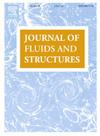基于三维SPH-FEM耦合方法的水弹性流固耦合求解器
IF 3.4
2区 工程技术
Q1 ENGINEERING, MECHANICAL
引用次数: 0
摘要
本工作旨在建立一个精确的数值自规划框架,通过拉格朗日粒子法和基于网格的耦合方法来模拟剧烈的三维流固耦合过程,其中流体动力载荷采用光滑粒子流体力学(SPH)求解,结构动力学采用有限元法(FEM)预测。需要注意的是,引入退化连续统理论来描述结构动力学,在某些情况下可以很容易地应用于复杂结构的离散化。同时,为克服流固界面附近流体粒子的支撑域截断的缺点,提出了一种法向通量法。此外,为了提高三维SPH-FEM求解器的耦合稳定性和鲁棒性,还采用了一些先进的数值处理技术,如δ-SPH模型和传统的顺序交错算法。最后,通过静水水柱试验、自由表面流-结构相互作用试验和弹性结构入水冲击试验等几个典型的水弹性基准试验和商业软件试验,对数值精度和整体稳定性进行了系统的讨论和验证,可以促进海洋工程中水弹性效应的数值算法研究。本文章由计算机程序翻译,如有差异,请以英文原文为准。
A hydroelastic fluid-structure interaction solver based on a coupled 3D SPH-FEM method
The present work is aimed at developing an accurate numerical self-programming framework to simulate the violent 3D fluid-structure interaction process by a coupled Lagrangian particle method and mesh-based method, where the hydrodynamic load is solved by smoothed particle hydrodynamics (SPH) and the structural dynamics is predicted by the Finite Element method (FEM). It should be noted that the degenerated continuum theory is introduced to describe the structure dynamics, which can be easily applied to the complex structure discretization in some cases. And at the same time, a normal flux approach is developed to overcome the shortcoming of support domain truncation for fluid particles near the fluid-structure interface. Additionally, some other advanced numerical processing techniques are employed to improve the coupling stability and robustness of the 3D SPH-FEM solver, such as the δ-SPH model and the conventional sequential staggered algorithm. Finally, through several typical hydro-elastic benchmark tests and commercial software tests, including the hydrostatic water column test, free surface flow-structure interaction and elastic structure water entry slamming test, the numerical accuracy and overall stability are discussed and verified systematically, which can promote the numerical algorithm research on hydro-elastic effect in ocean engineering.
求助全文
通过发布文献求助,成功后即可免费获取论文全文。
去求助
来源期刊

Journal of Fluids and Structures
工程技术-工程:机械
CiteScore
6.90
自引率
8.30%
发文量
173
审稿时长
65 days
期刊介绍:
The Journal of Fluids and Structures serves as a focal point and a forum for the exchange of ideas, for the many kinds of specialists and practitioners concerned with fluid–structure interactions and the dynamics of systems related thereto, in any field. One of its aims is to foster the cross–fertilization of ideas, methods and techniques in the various disciplines involved.
The journal publishes papers that present original and significant contributions on all aspects of the mechanical interactions between fluids and solids, regardless of scale.
 求助内容:
求助内容: 应助结果提醒方式:
应助结果提醒方式:


